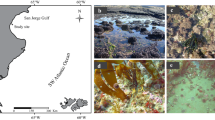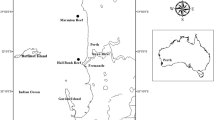Abstract
To examine the feeding ecology of the sea urchin Strongylocentrotus intermedius, two types of macroalgal diet (kelp Saccharina longissima and red alga Ptilota filicina) and four types of benthic animal diet [barnacle Balanus glandula, limpet Lottia cassis, free-living Perinereis aibuhitensis and P. aibuhitensis attached to a stainless steel wire (wired polychaete)], were separately or simultaneously provided for urchins of 5- to 60-mm test diameter (TD). Sea urchins of even 3-mm TD could graze the kelp, and began to graze the red alga, the wired polychaete and limpet by 5-mm TD, the barnacle by 8-mm TD and the free-living polychaete by 15-mm TD, respectively. These results suggest that the variety of macroalgae and benthic animals which the urchin can graze increases with the ontogeny of their feeding organs, motility and ability to catch animals. Both juvenile and adult sea urchins preferred to eat the polychaete as well as the kelp fronds. Feed conversion efficiency and daily growth rate of the small sea urchins fed benthic animals like the polychaete were higher than those fed macroalgae. The sea urchins are likely to grow better when feeding on animals than on macroalgae, even in habitats where they can access adequate quantities of kelp.









Similar content being viewed by others
References
Witman JD, Sebens KP (1992) Regional variation in fish predation intensity: a historical perspective in the Gulf of Maine. Oecologia 90:305–315
Vadas RL, Steneck RS (1995) Overfishing and inferences in kelp-sea urchin interactions. In: Skjoldal HR, Hopkins C, Erikstad KE, Leinaas HP (eds) Ecology of fjords and coastal waters. Amsterdam, Elsevier, pp 509–524
Estes JA, Tinker MT, Williams TM, Doak DF (1998) Killer whale predation on sea otters linking oceanic and nearshore ecosystems. Science 282:473–476
Lawrence JM (1975) On the relationships between marine plants and sea urchins. Oceanogr Mar Biol Annu Rev 13:213–286
Duggins DO (1980) Kelp beds and sea otters: an experimental approach. Ecology 61:447–453
Harrold C, Reed DC (1985) Food availability, sea urchin grazing, and kelp forest community structure. Ecology 66(4):1160–1169
Himmelman JH, Lavergne Y, Axelsen F, Cardinal A, Bourget E (1983) Sea urchins in the Saint Lawrence estuary: their abundance, size-structure, and suitability for commercial exploitation. Can J Fish Aquat Sci 40(4):474–486
Witman JD (1985) Refuges, biological disturbance, and rocky subtidal community structure in New England. Ecol Monogr 55(4):421–445
Kawamura K (1964) Ecological studies on sea urchin, Strongylocentrotus intermedius, on the coast of Funadomari in the North Region of Rebun Island. Sci Rep Hokkaido Fish Exp Stn 2:39–59 (in Japanese with English abstract)
Leighton DL (1971) Grazing activities of benthic invertebrates in southern California kelp beds. Nova Hedwigia 32:421–453
Ayling AL (1978) The relation of food availability and food preferences to the field diet of an echinoid Evechinus chloroticus (Valenciennes). J Exp Mar Biol Ecol 33(3):223–235
Duggins DO (1981) Sea urchins and kelp: the effects of short term changes in urchin diet. Limnol Oceanogr 26:391–394
Peterson BJ, Fry B (1987) Stable isotopes in ecosystem studies. Annu Rev Ecol Syst 18:293–320
Endo H, Nakabayashi N, Agatsuma Y, Taniguchi K (2007) Food of the sea urchins Strongylocentrotus nudus and Hemicentrotus pulcherrimus associated with vertical distributions in fucoid beds and crustose coralline flats in northern Honshu, Japan. Mar Ecol Prog Ser 352:125–135
Agnetta D, Bonaviri C, Badalamenti F, Scianna C, Vizzini S, Gianguzza P (2013) Functional traits of two co-occurring sea urchins across a barren/forest patch system. J Sea Res 76:170–177
Vance RR (1978) A mutualistic interaction between a sessile marine clam and its epibionts. Ecology 59:679–685
De Ridder C, Lawrence JM (1982) Food and feeding mechanisms: Echinoidea. In: Jangoux M, Lawrence JM (eds) Echinoderm nutrition. Balkema, Rotterdam, pp 57–115
Vásquez JA, Castilla JC, Santelices B (1984) Distributional patterns and diets of four species of sea urchins in giant kelp forest (Macrocystis pyrifera) of Puerto Toro, Navarino Island, Chile. Mar Ecol Prog Ser 19(12):55–63
Onitsuka T, Unuma T, Kawamura T (2014) Effects of diet and temperature on post-settlement growth and survival of the short-spined sea urchin Strongylocentrotus intermedius. Aquac Res 45:1–15
Onitsuka T, Niwa K, Unuma T, Umezu Y (2015) Dietary shifts in the juvenile sea urchin Strongylocentrotus intermedius associated with the development of digestive enzymes. Mar Biol 162:869–880
Machiguchi Y, Kitamura H (2012) Dietary value of five species of marine algae from the eastern part of Hokkaido for long term culture of juveniles of the sea urchin Strongylocentrotus intermedius. Aquac Sci 60:313–322 (in Japanese with English abstract)
Oshima Y, Isiwata N, Tanaka J (1957) Food habit of two species of sea-urchin. Aquac Sci 5:26–30 (in Japanese)
Tatarenko DE, Poltaraus AB (1993) Affiliation of the sea urchin Pseudocentrotus depressus to the family Strongylocentrotidae and description of a new genus Mesocentrotus belonging to this group based on DNA-DNA hybridization and comparative morphological data. Zool Zh 72(2):61–72
Yamauchi T, Hirano T (1995) Experiments on predation by the sea urchin Strongylocentrotus nudus on juvenile abalone Haliotis discus hannai in aquarium. Saibai Giken 23(2):117–120 (in Japanese)
Machiguchi Y (1987) Feeding behavior of sea urchin Strongylocentrotus intermedius observed in Y—shaped chamber. Bull Hokkaido Reg Fish Res Lab 51:33–37 (in Japanese with English abstract)
Machiguchi Y, Mizutori S, Sanbonsuga Y (1994) Food preference of sea urchin Strongylocentrotus nudus. Bull Hokkaido Natl Fish Res Inst 58:35–43 (in Japanese with English abstract)
Vadas RL (1977) Preferential feeding: an optimization strategy in sea urchins. Ecol Monogr 47:337–371
Mann KH, Wright JL, Welsford BE, Hatfield E (1984) Responses of the sea urchin Strongylocentrotus droebachiensis (OF Müller) to water-borne stimuli from potential predators and potential food algae. J Exp Mar Biol Ecol 79(3):233–244
Ivlev BC (1965) Experimental ecology of the feeding of fishes (translated from the Russian by Kodama Y and Yoshihara T). Shinkagaku bunkenkankokai, Yonago 26–76
Sato K, Notoya M (1988) Food value of Ecklonia stolonifera for growth of topshell, sea urchin and abalone. Nippon Suisan Gakkaishi 54(8):1451 (in Japanese)
Agatsuma Y (2000) Food consumption and growth of the juvenile sea urchin Strongylocentrotus intermedius. Fish Sci 66:467–472
Fuji A (1960) Studies on the biology of the sea urchin. II. Size at first maturity and sexuality of two sea urchin, Strongylocentrotus nudus and S. intermedius. Bull Fac Fish Hokkaido Univ 11:43–48
Uemura Y (1988) Quality and quantity of the gonad of Strongylocentrotus nudus fed with different diets: kelp or three fish meals. Aomori Pref Bull Fish Res Cen Aquac Inst 17:223–235 (in Japanese)
Acknowledgements
We thank K. Sugita and technical staff of the hatchery in Akkeshi city for providing sea urchins. We also thank Dr. T. Unuma and technical staff of Hokkaido National Fisheries Research Institute, Fisheries Research Agency for their support in collecting algae and benthic animals. This study was supported by the Coastal Ecosystem Complex Project of the Ocean Resources Use Promotion Technology Development Program of the Ministry of Education, Culture, Sports, Science and Technology Japan.
Author information
Authors and Affiliations
Corresponding author
Rights and permissions
About this article
Cite this article
Umezu, Y., Onitsuka, T., Kawamura, T. et al. Feeding of the short-spined sea urchin Strongylocentrotus intermedius on macroalgae and benthic animals. Fish Sci 83, 221–233 (2017). https://doi.org/10.1007/s12562-016-1056-y
Received:
Accepted:
Published:
Issue Date:
DOI: https://doi.org/10.1007/s12562-016-1056-y




